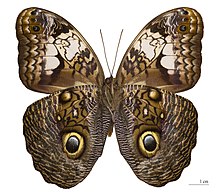| Owl butterflies | |
|---|---|

| |
| Caligo martia, underside | |
| Scientific classification | |
| Domain: | Eukaryota |
| Kingdom: | Animalia |
| Phylum: | Arthropoda |
| Class: | Insecta |
| Order: | Lepidoptera |
| Family: | Nymphalidae |
| Tribe: | Brassolini |
| Genus: | Caligo Hübner, [1819] |
| Type species | |
| Caligo eurilochus Cramer, 1775
| |
| Diversity | |
| Some 20 species | |
| Synonyms | |
| |
The owl butterflies are species of the genus Caligo and are known for their huge eyespots, which resemble owls' eyes. They are found in the rainforests and secondary forests of Mexico, Central and South America.
Owl butterflies are very large, 65–200 mm (2.6–7.9 in), and fly only a few meters at a time, so avian predators have little difficulty in following them to their settling place. However, the butterflies preferentially fly in dusk, when few avian predators are around.[1] The Latin name may possibly refer to their active periods; caligo means darkness.
Some owl butterflies form leks in mating behavior.[2]
- ^ André V. L. Freitas; Woodruff W. Benson; Onildo J. Marini-Filho; Roberta M. de Carvalho (1995). "Territoriality by the dawn's early light: The neotropical owl butterfly Caligo idomenaeus (Nymphalidae: Brassolinae)" (PDF). Journal of Research on the Lepidoptera. 34 (1–4): 14–20. Archived from the original (PDF) on 2016-03-03. Retrieved 2009-10-15.
- ^ Robert B. Srygley & Carla M. Penz (1999). "Lekking in neotropical owl butterflies, Caligo illioneus and C. oileus (Lepidoptera: Brassolinae)". Journal of Insect Behavior. 12 (1): 81–103. doi:10.1023/A:1020981215501. S2CID 30918158.